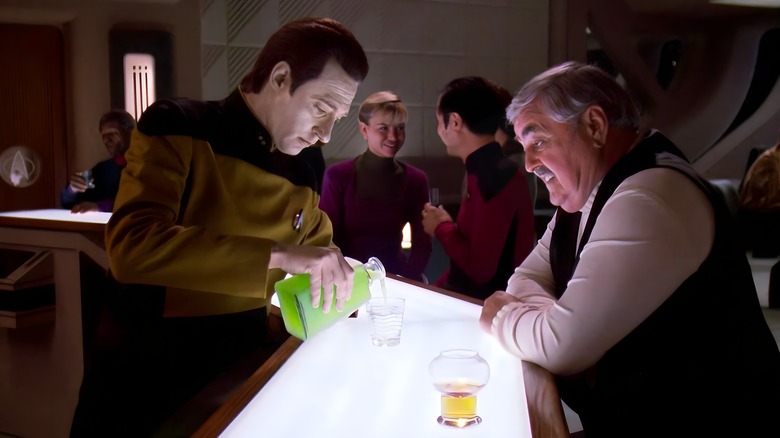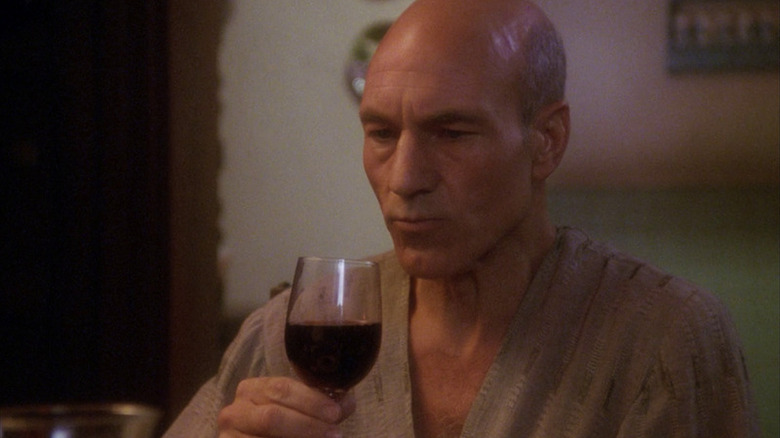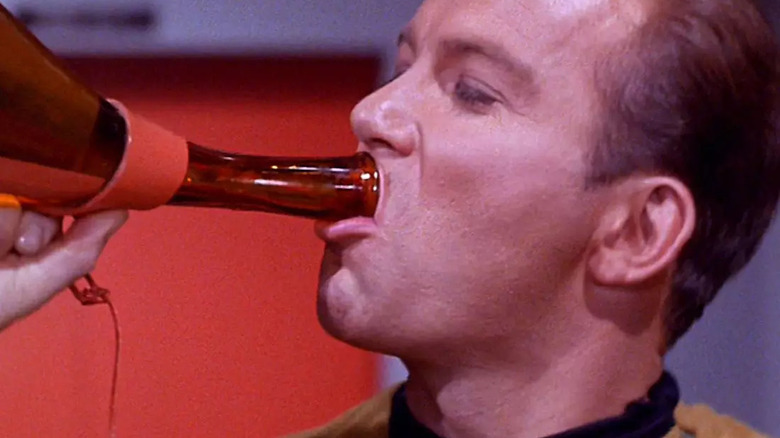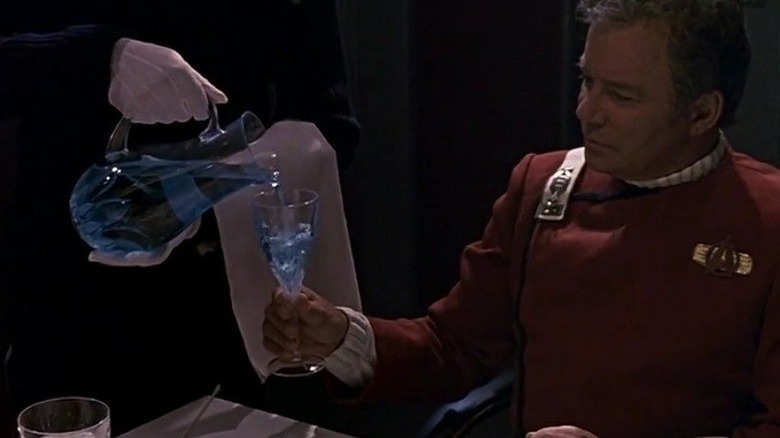Getting Drunk In The Star Trek Universe: Synthehol Explained
According to My Navy HR, "consumption of alcohol in the NWU [Naval Working Uniform] off-base is not permitted. Consumption of alcohol in the NWU on base is authorized as promulgated by Regional Commanders. The Area or Regional Commander may further restrict uniform policies within their geographical limits regarding wear of the NWU." According to actual naval code, drinking is not at all permitted on military vessels, as stated, "the introduction, possession or use of alcoholic beverages on board any ship, craft, aircraft, or in any vehicle of the Department of the Navy is prohibited." The website Recovery First says naval veterans are at a higher risk of alcoholism than other military branches.
I mention the Navy as that is the closest present-day comparison we have for Starfleet on "Star Trek." They use the same ranks, have a lot of the same nautical jargon, and seem to abide by a similarly militant sense of propriety. They also similarly seem barred from drinking alcohol while in uniform. Thanks to an episode of "Star Trek: The Next Generation" called "Symbiosis" (April 18, 1988), audiences know that chemical addiction is largely absent in the world of Starfleet. Wesley Crusher (Wil Wheaton) seems entirely baffled by the notion that anyone could become dependent on a substance.
Throughout "Star Trek," however, many characters are seen consuming alcohol and, in some cases, getting drunk. Scotty (James Doohan), for instance, seems to have a personal stash of high-ABV spirits in his quarters. In "Star Trek: First Contact" (1996), Counselor Troi (Marina Sirtis) is unfamiliar with tequila and doesn't recognize that she's drunk after having some.
But these are rare instances. For the most part, Starfleet officers refer to their drinks as containing a mystery liquor called synthehol.
What the heck is synthehol?
Synthehol
Synthehol is, of course, a portmanteau of synthetic and alcohol. The name implies that it is an alcohol-like beverage that possesses none of its intoxicating effects. If you're in the mood for a gin & tonic after a difficult shift on the bridge, you can go to the ship's galley, or perhaps Ten Forward, and chug one down and not feel tipsy or experience any liver damage. In my headcanon, the fake booze might replicate the warming feeling of alcohol as well.
Notably, synthehol wasn't in vogue until the days of "The Next Generation," when it was first mentioned in dialogue. Thanks to the nature of "Star Trek" canon, one can posit that synthehol existed in the original series but was not mentioned. This tracks when one takes into account an article in Star Trek: Communicator Magazine wherein Trek creator Gene Roddenberry stated that synthehol was invented by the Ferengi, a species not encountered in earnest until the 24th century.
The flavor of synthehol is, evidently, very different from the genuine article. Picard (Patrick Stewart) was accused by his brother Robert (Jeremy Kemp) in the episode "Family" (October 1, 1990) of losing his taste for good wine after drinking too much of the synthesized variety. In the episode "Relics" (October 12, 1992), Scotty was retrieved from a transporter buffer after being trapped inside of it for 75 years. Scotty, used to having real alcohol in his quarters, is fed some synthesized scotch, which he immediately rejects. Real drinkers, it seems, know the difference. By "Star Trek: Picard," the title character was back to making real wine in his family vineyard.
Yes, one can buy bottles of Château Picard in real life.
Synthehol, it seems, allowed for a new layer of booze snobbery in the 24th century.
Real booze
Expanded "Star Trek" universe lore explains a little bit as to why synthehol doesn't make most people drunk. It seems that synthehol contains some kind of synthetic enzyme that allows most humanoid species to break down the toxic elements of booze more quickly, causing the alcohol to pass through their bodies without harming them. It's likely, then, that synthehol does actually contain booze, but that it has no effect on the drinker. This was proven true when Seven of Nine (Jeri Ryan), a former Borg, found that her Borg implants prevented synthehol from being broken down in her system. She got drunk after a single glass of champagne in the "Star Trek: Voyager" episode "Timeless" (November 18, 1998).
The Ferengi barkeep Quark (Armin Shimerman), of course, often fed huge amounts of synthehol into his customers on Deep Space Nine. His bar appeared to be well-stocked, but it was rare that someone ordered the hard stuff on camera. This was counter to Ten Forward which, also seen in "Relics," had older bottles of actual liquor stored in secret under the table. Also in my own headcanon: Guinan (Whoopi Goldberg) kept the booze there illegally, but was given special dispensation by the captain. As a bartender, she knew that actual alcohol would be required every once in a while. This would also imply, however, that the Enterprise's replicators couldn't make real alcohol. Perhaps a clever hacker could break into the ship's food pattern database and remove the synthetic enzymes.
Of course, real booze was plentiful in the old days. In the original "Star Trek" series, Kirk (William Shatner) could be seen chugging a flagon of Saurian brandy. In "Star Trek II: The Wrath of Khan" (1982), audiences first heard of Romulan Ale.
Romulan Ale
Romulan Ale was like the "Star Trek" version of contraband Cuban cigars in the United States (which are legal now, thanks to Barack Obama). Captain Kirk and Dr. McCoy (DeForest Kelley) shared a bottle in "Khan," and it was used to toast a potential peace accord between the Federation and the Klingon Empire in "Star Trek VI: The Undiscovered Country" (1991). Every time it was consumed, its legality was mentioned. Although one might like to think that Romulan Ale was illegal because of its power or flavor, it seems that its illegality was merely part of a trade embargo between two uneasy political factions. In the "Star Trek: Deep Space Nine" episode "Inter Arma Enim Silent Leges" (March 3, 1999), it was mentioned that, thanks to wartime requirements, the trade embargo was lifted.
The embargo, however, was seemingly back in place by the events of "Star Trek: Nemesis" (2002), which mentioned Romulan Ale was illegal again. Worf (Michael Dorn) was holding his head in pain after drinking some.
One would think an enterprising Starfleet officer would have created a synthetic version of Romulan Ale while the embargo had been lifted, but there has been no reference in "Star Trek" to Romulan synthehol.
Curious fans, of course, have created their own down-home versions of the various cocktails, and some distilleries have made Romulan Ale (Star Trek Spirits has a rye whiskey and a vodka version of it). Homemade Romulan Ale is usually made from blue Curaçao, although any variation is acceptable. I, for one, would love to drink a Samarian Sunset, a drink that begins clear, but when the glass is flicked with a fingernail, becomes golden and cloudy. That sounds pleasant.



